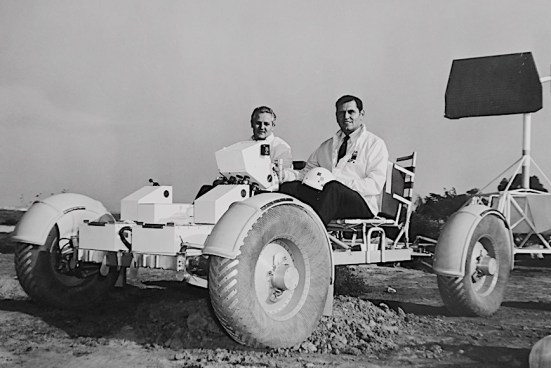The Lunar Rover’s 50th Anniversary and Its Goleta Roots
How the ‘Moon Buggy’ Was Developed by Local Engineers During Space Race

Shoot for the moon. The phrase is used often, but very few people have actually tried it. Today’s billionaires are spending fortunes breaking Earth’s atmosphere, and though Elon Musk’s Tesla Roadster made it to space, even his vehicle never touched rubber to the moon’s dusty surface.
July 31 marked the 50th anniversary of the Lunar Rover’s first deployment on the moon, manned by Commander David Scott and lunar-module pilot Jim Irwin on the historic Apollo 15 mission. But the rover’s 238,900-mile journey began ever further back, years before, and in our own backyard at Delco, a former General Motors defense research laboratory in Goleta.
The 17-month project cost nearly $38 million, and in that short time, the team of engineers designed, tested, and built four 460-pound, battery-powered, foldable Lunar Roving Vehicles. Three of them made trips to the moon, while one was kept on Earth for spare parts.
The Apollo program was front and center of the era’s Space Race and the focus of the world’s attention. The American effort was headed by GM engineers Sam Romano and Ferenc Pavlics, whose contributions changed the direction of the lunar missions, allowing astronauts to explore the moon’s surface and collect samples in a way that wouldn’t have been possible before the rovers.
Romano’s son, Tim Romano, remembers the fervor and energy of the Apollo program during the late ’60s and early ’70s. “It was a very dynamic time,” he said. “We’d watch the launches and landings with the backdrop of the Vietnam War.” While some men headed to the moon, Romano said, other “young kids” were at war.
Tim was around 11 years old at the time his father was working on the project, a prime age for looking up at the stars and dreaming big. He remembers the whole development team gathering at the family’s Rancho San Antonio home to celebrate successful missions. “We had huge parties,” he said. “It was mayhem.”
To this day, the Apollo rovers are the only vehicles to be driven on the moon. That is, until 2023, when NASA’s Volatiles Investigating Polar Exploration Rover (VIPER) will revitalize lunar exploration and make its first trek.
The early ’70s lunar rover resembled an off-road buggy, with woven-mesh metal tires specifically designed to resist sinking in the soft lunar soil. The tires worked perfectly; the soil was harder than expected and the treads left tracks only a half-inch deep.
Delco’s former location is now a business park in Goleta, and in the middle of the park stands a memorial to the lunar rover project, complete with a set of tracks made by those innovative treads.

The memorial was built in 2015, and Sam Romano’s daughter Laurie was instrumental in its design and completion. Kalie Grubb, a project manager with Arcadia Studios, helped Laurie with the landscape architecture.
“She had a special connection to Delco,” Grubb said. “Her family had one of the wheels of the rover in their possession, so we were able to take measurements and get a feel for how we wanted to design the monument.”
Sam passed away while Laurie and Grubb were working on the project, “so it took on an even more significant meaning,” Grubb said. Laurie died of cancer last year. “The finished product is a testament to Laurie’s determination to see her vision realized on a project she dedicated many years to,” Grubb said.
Tim Romano still works in town at Raytheon as an engineer, just like his dad — though he makes infrared sensors instead of moon buggies. He passes the memorial on his way to and from work, and on some days he stops by on his lunch break to remember the magic of the “moon days.”
It is a special place for him, and his family, a bunch of “Cal Poly engineers,” he said, and the legacy of those who shot for the moon and made it.
Support the Santa Barbara Independent through a long-term or a single contribution.




You must be logged in to post a comment.